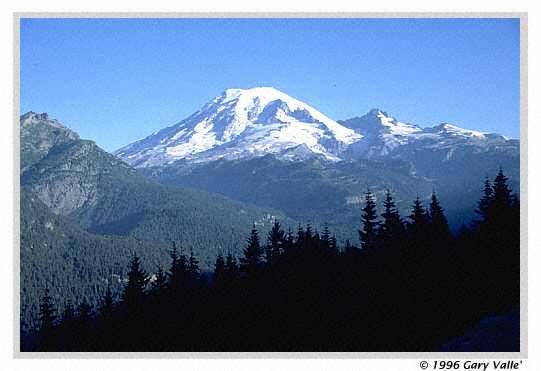 |
THE CASCADES Mt. Rainier |
 |
THE CASCADES Mt. Rainier |
|
What a mountain! Coming around the corner and seeing Mt. Rainier (14,411 ft.) for the first time was a lot like coming out of the Wawona Tunnel and seeing Yosemite. Paradise was stunning! One of my more unusual mountain experiences occurred on Mt. Rainier. Our plan was to do the mountain via a steep chute to the west of Nisqually Glacier. More... |
 |
What a mountain! Coming around the corner and seeing Mt. Rainier (14,411 ft.) for the first time was a lot like coming out of the Wawona Tunnel and seeing Yosemite. Paradise was stunning! |
|
|
One of my more unusual mountain experiences occurred on Mt. Rainier. Our plan was to do the mountain via a steep chute to the west of Nisqually Glacier. On a warm August day we began plodding up the trail from Paradise. Snowfall had been meager the previous Winter so the trail was free of snow. Rather than pristine and white, the glaciers on the lower half of the mountain were the dirty gray of bare glacial ice. Exposed by the lack of snow, crevasses seemed to cover every inch of ice. From time to time, the sound of huge ice blocks collapsing and falling would echo from the canyon. Initially our route followed the well-worn path to Camp Muir, but upon reaching the glacier , instead of trending right to the hut, we trended left toward a flat area at the top of a lateral moraine, near the base of the Nisqually Icefall. Here, at an elevation of about 10,000 ft., we hoped to cross the glacier. We made good time and reached the saddle early in the afternoon. We dumped our packs and made our first tentative attempt to find a way across the icefall. On the plus side, there were no hidden crevasses--you could seem them all. But on the minus side, a BIG minus in my mind, the temperature was well above freezing and the icefall was very active. The crevasses creaked and groaned, and on the steep area above our proposed route, house sized blocks would fall and shatter. I wanted nothing to do with it. My "little voice" was not whispering, it was shouting to the top of its lungs, "stay away!" This upset my climbing partners. Especially my buddy from Seattle. His position was that I was a rock jock from Southern Cal, and just didn't understand the subtleties of glaciers. My position was I didn't like big chunks of ice falling on my head. We finally agreed that we would wait until temps dropped, either crossing the jumbled ice mass at night, or early in the morning. Whew! The small saddle at the top of the moraine was an outstanding bivi site, commanding an incredible view. To the south and west, about 50 miles distant, was the truncated conical hulk of Mt. St. Helens. Just three months before the mountain had collapsed and imploded with catastrophic power and fury. As sunset became twilight, we began to cook dinner. Inevitably the conversation turned to St. Helens. Could you see it from Seattle? How much ash was there? Could you feel the earthquakes? It was about then we noticed a wisp of smoke coming from the volcano. Within minutes the wisp grew into a plume. The plume grew and thickened. We imagined we could see hot ash flows cascading down the side of the mountain. As the plume of ash reached the tropopause and spread, the weather began to change. Prior to the eruption it had been absolutely calm and clear. As darkness fell and temperatures dropped, ash-filled clouds blanketed the sky, and a light breeze began to blow down the mountain slopes. We hurriedly finished dinner and crawled into our bivi sacks, seeking refuge from the cold. Our bivi gear sheltered us from the deteriorating weather but not from thoughts of erupting and exploding mountains. The wind continued to increase and seemed to blow directly in the direction of St. Helens, as if filling the void created by the continuing eruption. Ash filled the air, and even though snug inside my bivi bag, with a handkerchief over my mouth, I would occasionally gag. Well into the night, snow and ash, driven by 60 m.p.h. winds, pelted our nylon bags. It was a fitful and introspective night. We were perched on the side of a sleeping giant, wondering if it too would come to life; on one hand fearing the power, and on the other, relishing it. In the morning we emerged from our cocoons to find a world where the upslope side of every rock and projection was coated with three or four inches of snow mixed with ash. It was difficult to tell just how big an eruption it had been. We worried it might be a precursor to an even bigger event, either on St. Helens, or under our feet, and hurried down off the mountain.
|
||
